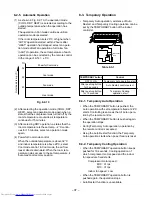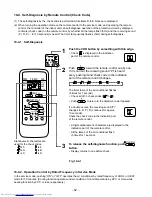
– 48 –
9-3-10. Check and Test Operation
For R410A, use the leak detector exclusively
manufactured for HFC refrigerant (R410A,
R134a, etc.).
*
The conventional leak detector for HCFC
refrigerant (R22, etc.) cannot be used because
its sensitivity for HFC refrigerant lowers to
approx. 1/40.
• Pressure of R410A becomes approx. 1,6 times
of that of R22. If installation work was
incompletely finished, a gas leakage may
occur in the cases such as pressure rise
during operation. Therefore, be sure to test the
piping connections for leaking.
Fig. 9-3-16
• Check the flare nut connections, valve stem
cap connections and service port cap
connections for gas leak with a leak detector or
soap water.
CAUTION
• Use a circuit breaker of a type that is not
tripped by shock waves.
• If incorrect/incomplete wiring is carried out,
it will cause an electrical fire or smoke.
• Prepare the power source for exclusive use
with the air conditioner.
• This product can be connected to the mains.
Connection to fixed wiring :
A switch or circuit breaker which
disconnects all poles and has a contact
separation of at least 3 mm must be
incorporate in the fixed wiring.
An approved short circuit breaker or
switches must be used.
*
(A breaker having a sensitivity of
approximately 0,1 second or less and
a capacity of approximately 30 mA is
usually used.)
9-3-11. MISWIRING (MISPIPING) CHECK
Make sure that the wiring and piping for each
room have the same alphabetical code (A, B, C).
Connect and secure the power cord.
Use the power cord / cables with thickness, type,
and protective devices specified in this manual.
Insulate the unused cords (conductors) with PVC
tape.
1. Turn on the electrical power breaker.
2. Operate the indoor unit with cooling mode.
3. Start the check.
•
Run the indoor unit in A room, and confirm
cool air blows out.
•
Confirm the indoor units in B, C rooms do
not run. (In this time, also check flowing
sound of refrigerant is not heard.)
•
Stop operation of the indoor unit in A
room, and execute the same checks on
the indoor unit in B and C rooms.
9-3-12. Useful Functions
Self-Diagnosis by LED Indication
• For this outdoor unit, the self-diagnosis is
possible by using five LEDs (Red).
• Refer to the table in page 61, for more details.
*
LEDs (Red) (D11 to D15) locate on the sub-
control board underneath of the inverter.
1. If a trouble occurs, LED (Red) goes on
according to the contents of trouble as shown
in the left table.
2. When two or more troubles occur, LEDs go on
cyclically (alternately).
3. Usually, LEDs (Red) go off.
• Flare nut connections
(Outdoor unit)
• Valve stem cap connection
• Service port cap connection
Flare nut connections
(Indoor unit)
Wiring port
D11 D12 D13 D14 D15
LED (Red)
9-3-13. Installation/Servicing Tools Changes in the product and components
In the case of an air conditioner using R410A, in order to prevent any other refrigerant from being
charged accidentally, to service port diameter of the outdoor unit control valve (3 way valve) has been
changed. (1/2 UNF 20 threads per inch)
• In order to increase the pressure resisting strength of the refrigerant piping flare processing diameter
and size of opposite side of flare nuts has been changed. (for copper pipes with nominal dimensions 1/
2 and 5/8)
New tools for R410A
Changes
As pressure is high, it is impossible to measure by means of
conventional gauge. In order to prevent any other refrigerant from
being charged, each port diameter has been changed.
In order to increase pressure resisting strength, hose materials and
port size have been changed (to 1/2 UNF 20 threads per inch).
When purchasing a charge hose, be sure to confirm the port size.
As pressure is high and gasification speed is fast, it is difficult to
read the indicated value by means of charging cylinder, as air
bubbles occur.
The size of opposite sides of flare nuts have been increased.
Incidentally, a common wrench is used for nominal diameters 1/4
and 3/8.
By increasing the clamp bar’s receiving hole, strength of spring in
the tool has been improved.
Used when flare is made by using conventional flare tool.
Connected to conventional vacuum pump. It is necessary to use an
adapter to prevent vacuum pump oil from flowing back to the charge
hose. The charge hose connecting part has two ports-one for
conventional refrigerant (7/16 UNF 20 threads per inch) and one for
R410A. If the vacuum pump oil (mineral) mixes with R410A a
sludge may occur and damage the equipment.
Exclusive for HFC refrigerant.
• Incidentally, the “refrigerant cylinder” comes with the refrigerant designation (R410A) and protector
coating in the U. S’s ARI specified rose color (ARI color code: PMS 507).
• Also, the “charge port and packing for refrigerant cylinder” require 1/2 UNF 20 threads per inch
corresponding to the charge hose’s port size.
New tools for R410A
Applicable to R22 model
Gauge manifold
X
Charge hose
X
Electronic balance
for refrigerant charging
¡
Torque wrench
(nominal diam. 1/2, 5/8)
X
Flare tool
¡
(clutch type)
Gauge for projection
—
——
adjustment
Vacuum pump adapter
¡
Gas leakage detector
X
Fig. 9-3-17
















































